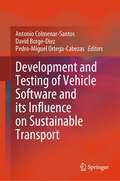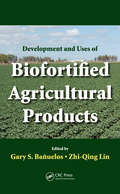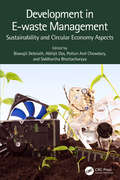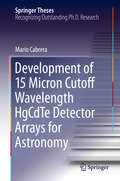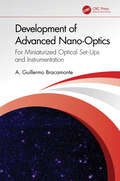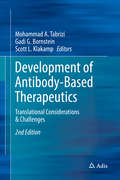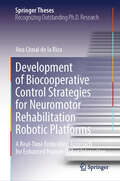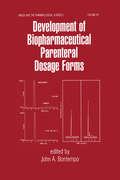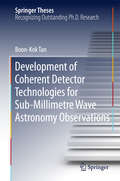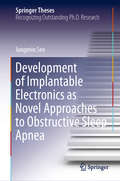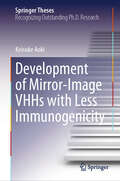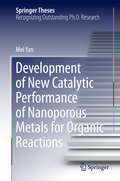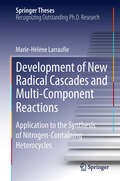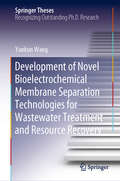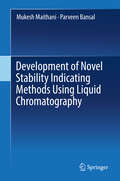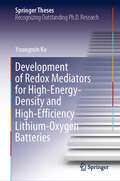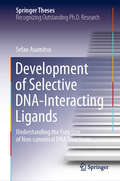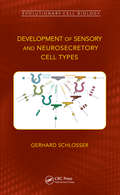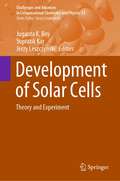- Table View
- List View
Development and Testing of Hand Exoskeletons (Springer Theses)
by Matteo BianchiThis book describes the development of portable, wearable, and highly customizable hand exoskeletons to aid patients suffering from hand disabilities. It presents an original approach for the design of human hand motion assistance devices that relies on (i) an optimization-based kinematic scaling procedure, which guarantees a significant adaptability to the user’s hands motion, and (ii) a topology optimization-based design methodology, which allowed the design of a lightweight, comfortable device with a high level of performance. The book covers the whole process of hand exoskeleton development, from establishing a new design strategy, to the construction and testing of hand exoskeleton prototypes, using additive manufacturing techniques. As such, it offers timely information to both researchers and engineers developing human motion assistance systems, especially wearable ones.
Development and Testing of Vehicle Software and its Influence on Sustainable Transport
by Antonio Colmenar-Santos David Borge-Diez Pedro-Miguel Ortega-CabezasThis book evaluates the contributions of the electronic control unit software of an electric vehicle on sustainability and society, such as the reduction of emissions during a product design and the improvements in the vehicle. A sustainable transport model is proposed, demonstrating its economic viability. By validating software in a more efficient way and adding new functionalities to the software to enhance driving efficiency, energy consumption can be significantly reduced. Therefore, software validation and development have a significant impact on sustainability. This book offers innovative validation solutions based on artificial intelligence techniques to reduce validation time and emissions. The impact of driving efficiency on sustainable transport models is studied in detail, making proposals to be considered in the current environmental policies under discussion within the European Union in order to improve the sustainability of transport models. Vehicles are becoming sophisticated electronic systems due to the fact that they are integrating a significant number of electronic control units. This trend will certainly continue in the year to come. Consequently, software validation techniques are a key element for car manufacturers in order to ensure the quality of the vehicle. This book contributes to these efforts.
Development and Uses of Biofortified Agricultural Products
by Zhi-Qing Lin Gary S. BañuelosAlthough ending world hunger remains the most important goal, increasingly the focus is on simultaneously improving world malnutrition. Paradoxically, nutritionally important trace elements essential for human health are both deficient and over-abundant in soils in many regions of the world. Using a multidisciplinary approach, Development and Uses
Development in E-waste Management: Sustainability and Circular Economy Aspects
by Abhijit Das Siddhartha Bhattacharyya Biswajit Debnath Potluri Anil ChowdaryThis book concerns the developments in the field of e-waste management with a particular focus on urban mining, sustainability, and circular economy aspects. It explains e-waste recycling technologies, supply chain aspects, and e-waste disposal in IT industries, including health and environmental effects of e-waste recycling processes, and associated issues, challenges, and solutions. Further, it describes the economic potential of resource recovery from e-waste. Features: Covers recent developments in e-waste management Explores technological advances, such as nanotech from e-waste, MREW, fungal biotech, and so forth Reviews electronic component recycling aspects Discusses the implementation of circular economy in the e-waste sector Includes urban mining and sustainability aspects of e-waste This book is aimed at graduate students and researchers in environmental engineering, waste management, urban mining, circular economy, waste processing, electronics, and telecommunication engineering, electrical and electronics engineering, and chemical engineering.
Development of 15 Micron Cutoff Wavelength HgCdTe Detector Arrays for Astronomy (Springer Theses)
by Mario CabreraThis thesis describes advances in the understanding of HgCdTe detectors. While long wave (15 μm) infrared detectors HgCdTe detectors have been developed for military use under high background irradiance, these arrays had not previously been developed for astronomical use where the background irradiance is a billion times smaller. The main pitfall in developing such arrays for astronomy is the pixel dark current which plagues long wave HgCdTe. The author details work on the success of shorter wavelength development at Teledyne Imaging Sensors, carefully modeling the dark current–reverse bias voltage curves of their 10 μm devices at a temperature of 30K, as well as the dark current–temperature curves at several reverse biases, including 250 mV. By projecting first to 13 and then 15 μm HgCdTe growth, values of fundamental properties of the material that would minimize tunneling dark currents were determined through careful modeling of the dark current-reverse bias voltage curves, as well as the dark current-temperature curves. This analysis was borne out in the 13 μm parts produced by Teledyne, and then further honed to produce the necessary parameters for the 15 μm growth. The resulting 13 μm arrays are being considered by a number of ground-based astronomy research groups.
Development of Advanced Nano-Optics: For Miniaturized Optical Set-Ups and Instrumentation
by A. Guillermo BracamonteThis book discusses advanced nano-optics, from proof of concepts to real applications in devices and miniaturized instrumentation. It covers various themes and topics within nanochemistry and physics that produce enhanced optical and smart responsive materials.Development of Advanced Nano-Optics is about the development of nano-optics with advanced nanochemistry control in order to adjust physical phenomena towards new advanced and enhanced properties and related applications. It explores the development of various physical phenomena, such as the generation of high-frequency electromagnetic fields in the near field show, that have an effect in the far field. The author discusses nano-optoelectronics, light scattering nano-optics, quantum nano-optics, and advances in nanospectroscopy. He also presents proof of concepts from nanochemistry and nano-optics towards advanced applications in nanotechnology and the life sciences. Nano-optical materials in microdevices and miniaturized instrumentation are also presented and discussed.This book is written for a wide range of readers, from undergraduate students to advanced researchers, academics, and practising engineers in industry working in the fields of optics, miniaturized instrumentation, and materials.
Development of Antibody-Based Therapeutics
by Gadi G. Bornstein Scott L. Klakamp Mohammad A. TabriziTranslational strategies for development of antibody-based therapeutics should allow understanding of the relationship between the 'unit dose' and 'unit effect' with respect to both beneficial and deleterious effects from early stages of development. The flow of information from later to earlier stages of development should provide opportunities to facilitate selection of more effective novel and next-generation drug candidates. Selection and evaluation of relevant biomarkers in early preclinical development in "relevant" animal models should allow for identifying potential risks to humans and establishing safe First-In-Human (FIH) dosing strategies. Hence, integration of knowledge with respect to target antigen properties such as antigen distribution, expression profile, kinetic properties, target pharmacology, antigen isoforms and pharmacological redundancy in health and disease, as well as antibody design criteria, such as antibody isotype, affinity, PK/PD and safety is a critical necessity for the design of effective translational strategies. Additionally, these factors will further offer critical differentiating characteristics for next-generation antibodies, and novel technologies prove instrumental in generation of biosuperior antibody candidates for market entry. This book will examine many important considerations necessary for the design of effective translational strategies during the development of antibody-based therapeutics.
Development of Antibody-Based Therapeutics: Translational Considerations
by Gadi G. Bornstein Scott L. Klakamp Mohammad A. TabriziWith a key focus on recent developments and advances in the field, this book provides in-depth coverage of topics fundamental to the development of targeted therapeutics. The expansion of targeted modalities in rapidly evolving therapeutic areas, such as immune-oncology, and developments with respect to combination therapies, novel technologies, and the therapeutic application of antibody-drug conjugates, are presented. Additionally, the book builds upon topics discussed in the first edition (2012) where recent innovations warrant elaboration. This, the second edition of Development of Antibody-Based Therapeutics: Translational Considerations, represents a comprehensive evaluation of progress in the field, which sits alongside the first edition to inform, in detail, professional and academic researchers, as well as graduate students.
Development of Biocooperative Control Strategies for Neuromotor Rehabilitation Robotic Platforms: A Real-Time Embedded Approach for Enhanced Human-Robot Interaction (Springer Theses)
by Ana Cisnal de la RicaThis book presents the development of a multimodal physiological signal acquisition system and cooperative control strategies for applications in upper-limb robotic rehabilitation. First, it introduces a non-pattern recognition EMG-based platform for hand rehabilitation, demonstrating its strong performance in both gesture recognition accuracy and responsiveness. It also discusses the role of EMG-based visual feedback, showing how real-time visualization of muscle activation enhances user performance during training. In turn, it reports on the validation of a low-cost multimodal acquisition solution using two different real-time biocooperative control strategies. The results demonstrate that the developed low-cost wearable platform, which integrates multiple sensors, wireless communication, and a high-efficiency real-time microcontroller, is highly versatile and configurable, and shows a good signal quality. By addressing two main aspects that limit the adoption of biocooperative systems in clinical rehabilitation settings – hardware affordability and system reliability – this outstanding Ph.D. thesis paves the way to the implementation of real-time biocooperative controls for future applications in robotic rehabilitation.
Development of Biopharmaceutical Parenteral Dosage Forms
by John A. BontempoThis up-to-the-minute reference delineates-in a systematic fashion-the appropriate, sequential steps for the formulation of safe, effective, stable, and marketable liquid parenteral biopharmaceutical products-covering fundamentals and essential pathways for each phase as well as its purpose, function, and relation to other stages in the product development process. Written by experts currently involved in state-of-the-art advances in the pharmaceutical drug industry, Development of Biopharmaceutical Parenteral Dosage Formsdetails biopharmaceuticals that are licensed or undergoing clinical development, including genetically engineered cell and engineered vectors in the fermentation process describes purification and characterization techniques for rDNA therapeutics, discussing several types of unit operations for isolation, purification, and characterization considers preformulation and formulation requirements, such as physicochemical properties, drug delivery, stability studies programs, deactivation/denaturation routes, selection of compatible excipients, and regulatory compliance elucidates basics of analytical techniques, methods development, separation methods using chromatographic and electrophoretic techniques, and bioactivity methods covering bioassays and immunoassays for quantifying the stability of biological activity shows how to select the appropriate filter for maximizing compatibility and minimizing adsorption and inactivation, examining topics from basic filtration theories to future trends reviews the selection process for compatible elastomeric closures, analyzing physical, chemical, toxicological properties, protein adsorption on elastomeric surfaces, strategies to reduce/eliminate adsorption, and specialized containers for biotechnological applications and more! Furnished with helpful references, tables, and drawings, this practical guide is indispensable.
Development of Coherent Detector Technologies for Sub-Millimetre Wave Astronomy Observations
by Boon-Kok TanThe thesis describes the development of receiver technologies for sub-millimetre astronomy instruments, focusing on high performance coherent cryogenic detectors operating close to the superconductor gap frequency. The mixer chip which comprises the SIS devices, fed by a unilateral finline and matching planar circuits was fabricated on 15 micron silicon substrate using the recently developed Silicon-On-Insulator (SOI) technology. This offered broadband IF and RF performance, with fully integrated on-chip planar circuits resulting in an easily reproducible mixer chip and a simple mixer block. An important consequence of this design is that it can be extended to the supra-THz region and making the fabrication of multi-pixel heterodyne arrays feasible. The extension of the operation of major telescopes such as ALMA, APEX and the GLT from single pixel to large format arrays is the subject of extensive research at present time since it will allow fast mapping combined with high resolution of the submillimetre sky. The technology described in this thesis makes a major contribution to this effort.
Development of Implantable Electronics as Novel Approaches to Obstructive Sleep Apnea (Springer Theses)
by Jungmin SeoThis book addresses novel methods to treat a very popular disease, obstructive sleep apnea, based on a knowledge of an electrical engineering. Two approaches are given in the book using an upper-airway stimulation based on the pathogenesis of an obstructive sleep apnea. Implantable electronics are devised to control the tongue and the soft palate considering that they are the major pharyngeal muscles contributing to the apnea. First, for tongue control, a cuff electrode was designed and fabricated to stimulate the hypoglossal nerve, which innervates to the tongue muscle. Rare-earth magnets were embedded in the cuff for easy and repeatable installation of the electrode. For soft palate control, a palatal implant system was firstly developed to contract the soft palate muscle by applying electrical stimuli. Comprised of an implant, an intra-oral device, and an external controller, the palatal implant system is fully powered and controlled by means of wireless communication. The approaches were demonstrated in both in vitro and in vivo assessments, in collaboration with department of Otorhinolaryngology, Seoul National University Bundang Hospital.
Development of In-Tether Carbon Chiral Center-Induced Helical Peptide: Methodology and Applications (Springer Theses)
by Kuan HuThis book focuses on the development of stapled peptides, a novel molecular modality used to regulate aberrant intracellular protein–protein interactions (PPIs). The author designs and presents a novel helical peptide stabilization methodology by constructing a chiral cross-linker moiety, namely “chiral center induced peptide helicity (CIH)”. The book demonstrates that a precisely positioned carbon chiral center on tether can decisively determine the secondary structure of a peptide, and that the R-configured peptide is helical, while the S-configured peptide is non-helical. Further, it reports that helicity-enhanced R isomer peptides displayed significantly enhanced cell permeability and target binding affinity, as well as tumor inhibition efficiency, in comparison to S isomer peptides. The book will not only advance readers’ understanding of the basic principle of stapled peptides, but also accelerate the clinical transformation of stapled peptide drugs.
Development of Mirror-Image VHHs with Less Immunogenicity (Springer Theses)
by Keisuke AokiThis book outlines the chemical synthesis of therapeutic targets and a screening process for unexplored mirror-image single-domain antibodies (D-VHH). This book first describes the chemical synthesis of model VHH and the characteristics of both enantiomeric VHHs, including binding activity, biodistribution and immunogenicity. Immunogenicity testing in mice demonstrated that administration of conventional L-VHH induced the generation of anti-drug antibodies while D-VHH-binding antibodies were not observed in D-VHH-immunized mice. Second, it is explained that the T7-phage-based mirror-image screening system was developed to identify D-VHH antibody fragments capable of binding to vascular endothelial growth factors. Additionally, this book details the chemical synthesis of full-length hepatitis B virus core protein and interleukin-6 for the application of exploring D-VHHs and other mirror-image molecules. Demonstrating that it is possible to develop a D-VHH that preferentially binds the native target protein and exhibits reduced immunogenicity, this book is useful for anyone interested in developing alternative biotherapeutics with reduced immunogenicity by combining chemical and biological approaches.
Development of New Catalytic Performance of Nanoporous Metals for Organic Reactions
by Mei YanIn this thesis, the focus is on the study of new catalytic properties of unsupported nanoporous metals in heterogeneous organic reactions under liquid-phase conditions. The author was the first to fabricate nanoporous copper with tunable nanoporosity and apply it for organic reactions. The catalyst can be reused up to ten times without loss of catalytic activity. In addition, the author developed the highly selective semihydrogenation of alkynes using nanoporous gold as a catalyst for the first time, affording Z-alkenes in 100% selectivity, which cannot be realized by traditional catalysts. All of the results described here will help readers to develop new catalytic performance of nanoporous metals for organic reactions.
Development of New Radical Cascades and Multi-Component Reactions
by Marie-Helene LarraufieIn this dissertation, Marie-Hélène Larraufie develops original radical and pallado-catalyzed methodologies to enable the synthesis of several classes of bioactive nitrogen-containing heterocycles. New radical cascades employing the N-acylcyanamide moiety offer straightforward routes to quinazolinones and guanidines, as well as new insights into the mechanism of homolytic aromatic substitutions. In parallel, Larraufie expands the scope of visible light photoredox catalysis to the ring opening of epoxides and aziridines, thus providing new sustainable alternatives for the generation of radicals. Furthermore, in a collaborative effort with the Catellani group, the author investigates dual palladium/norbornene catalysis. First, she develops a C-amination coupling variant of the Catellani reaction with unprotected amines which provides an expeditious route to phenanthridines. Then, she examines the influence of the chelating effect on Pd(IV) intermediates reactivity with the help of experimental studies and DFT calculations. The work in this thesis has resulted in numerous publications in high impact journals. The clarity and depth of the experimental section will be useful for students and researchers working in this field.
Development of Novel Bioelectrochemical Membrane Separation Technologies for Wastewater Treatment and Resource Recovery (Springer Theses)
by Yunkun WangThe most commonly used biological wastewater treatment technologies still have serious technical-economical and sustainability-related limitations, due to their high energy requirements, poor effluent quality, and lack of energy and resource recovery processes. In this thesis, novel electrochemical membrane bioreactors (EMBRs), which take advantage of membrane separation and bioelectrochemical techniques, are developed for wastewater treatment and the simultaneous recovery of energy and resources. Above all, this innovative system holds great promise for the efficient wastewater treatment and energy recovery. It can potentially recover net energy from wastewater while at the same time harvesting high-quality effluent. The book also provides a proof-of-concept study showing that electrochemical control might offer a promising in-situ means of suppressing membrane fouling. Lastly, by integrating electrodialysis into EMBRs, phosphate separation and recovery are achieved. Hence, these new EMBR techniques provide viable alternatives for sustainable wastewater treatment and resource recovery.
Development of Novel Hydrogen-Bond Donor Catalysts
by Tsubasa InokumaThis work describes novel, effective hydrogen-bond (HB) donor catalysts based on a known bifunctional tertiary amine-thiourea, a privileged structure, which has been proven to be one of the most widely used organocatalysts. These HB donor catalysts derived from quinazoline and benzothiadiazine were initially synthesized as novel HB donors with their HB-donating abilities being measured by analytical methods. They were found to be effective for a variety of asymmetric transformations including Michael reactions of a, b-unsaturated imides and hydrazination reactions of 1,3-dicarbonyl compounds. Thiourea catalysts that have an additional functional group are also described. Specifically, thioureas that bear a hydroxyl group were synthesized and subsequently used as novel bifunctional organocatalysts for catalytic, asymmetric Petasis-type reactions involving organoboronic acids as nucleophiles. These addition reactions were difficult to achieve using existing organocatalysts. One of the developed catalytic methods can be applied to the synthesis of biologically interesting peptide-derived compounds possessing unnatural vinyl glycine moieties. These findings introduce new criteria required for the development of organocatalysts for asymmetric reactions, thus making a significant contribution to the field of organocatalysis.
Development of Novel Stability Indicating Methods Using Liquid Chromatography
by Mukesh Maithani Parveen BansalReversed-phase high-performance liquid chromatography (RP-HPLC) has become the most widely used method for pharmaceutical analysis, as it ensures accuracy, specificity and reproducibility for the quantification of drugs, while avoiding interference from any of the excipients that are normally present in pharmaceutical dosage forms. This book presents a simple methodology for developing stability-indicating methods and offers a ‘how-to guide’ to creating novel stability-indicating methods using liquid chromatography. It provides the detailed information needed to devise a stability-indicating method for drug substances and drug products that comply with international regulatory guidelines. As such, it is a must-read for anyone engaged in analytical and bioanalytical chemistry: professionals at reference, test, and control laboratories; students and academics at research laboratories, and scientists working for chemical, pharmaceutical, and biotechnology companies.
Development of Redox Mediators for High-Energy-Density and High-Efficiency Lithium-Oxygen Batteries (Springer Theses)
by Youngmin KoThis thesis addresses the introduction of redox mediator into lithium-oxygen batteries to improve their electrochemical performance especially in terms of practical energy density and round-trip efficiency. In chapter 1, basic electrochemistry regarding lithium-oxygen batteries and redox mediators are introduced. In chapter 2 to 4, comprehensive researches including the discovery of a new redox mediator inspired by biological system, the investigation on kinetic property of redox mediator, and the prevention of shuttle phenomenon are introduced, followed by chapter 5 summarizing the contents. This thesis is targeted to students and researchers interested in electrochemistry and energy storage systems.
Development of Science Teachers' TPACK
by Ying-Shao HsuScience is a subject matter that requires learners to explore the world and develop their own abilities on the basis of that exploration. As technology broadens and deepens, science teachers need to expand their Technological Pedagogical Content Knowledge (TPACK), which determines how well they use technology to help students learn science. The book details our efforts to prepare science teachers to teach with the help of technology, examining various aspects of teacher education, professional development and teaching material preparation. It consists of three parts, which focus on: how TPACK is conceptually constructed within the field of science education, how teacher evaluation and teaching materials are developed and utilized based on the transformative model and how science teachers are prepared and supported with electronic resources based on the integrative model. The book offers a valuable resource for all those working in science education, as well as those readers who are interested in teacher education. Science teachers will come to know how simulations and animations can pedagogically support student learning. Practices for teachers' TPACK development such as learning-by-design, evaluation and measurement and teacher communities are also addressed, applied and discussed in the case of science teachers. The individual chapters will provide teacher educators and researchers from all disciplines with new insights into preparing teachers for the Digital Era.
Development of Selective DNA-Interacting Ligands: Understanding the Function of Non-canonical DNA Structures (Springer Theses)
by Sefan AsamitsuThis book addresses the development of both DNA-sequence-selective and DNA-form-selective ligands, with the aim of creating potential molecular probes and therapeutic agents for non-canonical DNA structure-caused human diseases. Over the past two decades, the structural diversity of DNA forms has been proven to have profound implications in various biological, neurological, and pharmacological events. In response, researchers have since made tremendous efforts to obtain highly active drugs interacting with disease-related non-canonical DNA structures. These drugs, however, have not yet been approved for clinical use. One obstacle impeding their clinical application has to do with selectivity. This book focuses on secondary DNA structures formed by trinucleotide repeat sequences (“hairpin form”) or guanine-rich sequences (“G-quadruplex form”), both of which are pathological molecules for neurodegenerative diseases and/or cancer. Most importantly, it contends that a particular secondary structure of DNA in the context of the human genome can be targeted with a minimal affinity to other DNA structures by means ofcareful and rational ligand design. This approach opens an avenue to the development of highly selective drugs or diagnostic chemical tools for human diseases. Readers who want to know how synthetic ligands can be designed to selectively target a certain DNA molecule will find this book highly informative.
Development of Sensory and Neurosecretory Cell Types: Vertebrate Cranial Placodes, volume 1 (Evolutionary Cell Biology)
by Gerhard SchlosserMost of the cranial sense organs of vertebrates arise from embryonic structures known as cranial placodes. Such placodes also give rise to sensory neurons that transmit information to the brain as well as to many neurosecretory cells. This book focuses on the development of sensory and neurosecretory cell types from cranial placodes by introducing the vertebrate head with its sense organs and neurosecretory organs and providing an overview of the various cranial placodes and their derivatives, including evidence of common embryonic primordia. Schlosser discusses how these primordia are established in the early embryo and how individual placodes develop. The latter chapters explain how various placodally derived sensory and neurosecretory cell types differentiate into discrete structures.
Development of Smart Context-Aware Services for Cargo Transportation: An Operational Management Approach (International Series in Operations Research & Management Science #330)
by Dalė Dzemydienė Aurelija Burinskienė Kristina Čižiūnienė Arūnas MiliauskasWith a focus on cargo transportation, this book addresses the development of approaches intended to secure an infrastructure of smart services to support the adaptive implementation of online multi-modal freight transport management processes. It discusses the development of multi-criteria decision-making components and their integration into the multi-layered computer-based information management of intelligent systems. Through detailed descriptions of various components of intelligent transport management systems, the book demonstrates how to develop the services needed in the right place and at the right time, and how to properly adapt to user needs, making necessary interventions to ensure the safety of the transportation process. Further, it describes the main ways to increase the autonomy and efficiency of user-vehicle interaction and shows how Information and Communications Technology (ICT) structural support for current and past situations in AI-based systems can help to anticipate future developments in freight transportation.
Development of Solar Cells: Theory and Experiment (Challenges and Advances in Computational Chemistry and Physics #32)
by Jerzy Leszczynski Supratik Kar Juganta K. RoyThis book presents a comprehensive overview of the fundamental concept, design, working protocols, and diverse photo-chemicals aspects of different solar cell systems with promising prospects, using computational and experimental techniques. It presents and demonstrates the art of designing and developing various solar cell systems through practical examples. Compared to most existing books in the market, which usually analyze existing solar cell approaches this volume provides a more comprehensive view on the field. Thus, it offers an in-depth discussion of the basic concepts of solar cell design and their development, leading to higher power conversion efficiencies. The book will appeal to readers who are interested in both fundamental and application-oriented research while it will also be an excellent tool for graduates, researchers, and professionals working in the field of photovoltaics and solar cell systems.

